Supporting Information
Synthesis, structure and electrochemical properties of triarylamine bridged dicobaltdicarbon tetrahedrane clusters.
Wing Y. Man, Kevin B. Vincent, Howard J. Spencer, Dmitry S. Yufit, Judith A.K. Howard, Paul J. Low*
Department of Chemistry, Durham University, South Rd, Durham, DH1 3LE, UK
S2 – S4Experimental details: synthesis of [Me3SiC≡CC6H4Me-4] and [{Co2(CO)4(dppm)}{µ-(Me3SiC2-C6H4-Me-4)}] (7).
S4 Electrochemistry
S5The spectroelectrochemically determined IR spectra of 7 and [7]+ in CH2Cl2 / 0.1 M [NBu4]PF6. NIR transitions of the electrochemically generated [4]+ and [7]+ in CH2Cl2 / 0.1 M [NBu4]PF6 and the chemically generated [6]+ and [6]2+ in CH2Cl2 at – 40 C.
S6 References
Experimental
General conditions. All reactions were carried out under an atmosphere of nitrogen using standard Schlenk techniques. Reaction solvents were purified and dried using an Innovative Technology SPS-400, and degassed before use. No special precautions were taken to exclude air or moisture during work-up. The compounds[Me3SiC≡CC6H4Me-4][S1] and [{Co2(CO)4(dppm)}{µ-(Me3SiC2-C6H4-Me-4)}](7) [S2]were prepared by literature routes, or minor modifications as detailed below. Other reagents were purchased and used as received.
The NMR spectra were recorded on a 400 MHz Bruker Avance, spectrometer from deuterated chloroform solutions and referenced against residual protio solvent resonances (CHCl3: 1H 7.26 ppm; 13C 77.0 ppm) or external phosphoric acid. IR spectra were recorded using a Thermo 6700 spectrometer from CH2Cl2 solutions in a cell fitted with CaF2 windows. MALDI -mass spectra of organometallic complexes were recorded using Autoflex II TOF/TOF mass spectrometer with a 337 nm laser. Samples in CH2Cl2 (1 mg / ml) were mixed with a matrix solution of trans-2-[3-(4-tert-butylphenyl)-2-methyl-2-propenylidene]malononitrile (DCTB) in a 1:9 ratio, with 1 l of mixture spotted onto a metal target prior to exposure to the MALDI ionization source. Organic compounds were analysed by GC-EI(+) mass spectrometry using a Trace GCMS instrument. Elemental analyses were performed by technical staff at the Department of Chemistry, Durham University.
Electrochemical analyses were carried out using an EcoChemie Autolab PGSTAT-30 potentiostat, with platinum working, platinum counter and platinum pseudo reference electrodes, from solutions in CH2Cl2 containing 0.1 M supporting electrolyte, = 100 mV s-1. The decamethylferrocene / decamethylferrocenium (FcH*/FcH*+) couple was used as an internal reference for potential measurements such that the FcH/FcH+ couple falls at 0.00 V (FcH*/FcH*+ = –0.48 V). [S3]Spectroelectrochemical measurements were made in an OTTLE cell of Hartl design [S4]from CH2Cl2 solutions containing 0.1 M [NBu4]PF6 electrolyte. The cell was fitted into the sample compartment of the Thermo 6700 or Thermo Array UV-Vis spectrophotometer, and electrolysis in the cell was performed with a PGSTAT-30 potentiostat. In 13C NMR assignments, the various C6H4 and C6H5 rings are denoted Ar (for the phenyl ring pendent to the methyl group) and Ph for those rings associated with the dppm ligand.
Syntheses
Preparation of [Me3SiC≡C6H4Me-4] Dry triethylamine (50 ml) was added to an oven dried flask and the solvent rigorously degassed by freeze pump thaw (3 cycles). The reagents iodotoluene (1.40 g, 6.42 mmol), Me3SiC≡CH(1.8 ml, 12.8 mmol), [Pd(PPh3)4] (0.15 g, 0.13 mmol) and CuI (0.024 g, 0.13 mmol) were added successively and the reaction mixture heated to reflux for 18 hours. The reaction was then allowed to cool to room temperature and the amine salt removed by filtration. The solvent was removed from the filtrate via Schlenk techniques to give a yellow-brown oil. Purification by column chromatography using hexane as an eluent gave a light yellow oil (0.90 g, 74 %). 1H NMR: δ 0.25 (s, 9H, SiMe3), 2.34 (s, 3H, CH3), 7.10 (d, J = 8 Hz, 2H, Ar), 7.36 (d, J = 8 Hz, 2H, Ar). 13C NMR: δ 0.4 (s, SiMe3), 21.9 (s, CH3), 93.5 (s, C≡CSiMe3), 105.7 (s, C≡CSiMe3), 120.4 (s, Ari), 129.3 (s, Aro), 132.2 (s, Arm), 138.8 (s, Arp).
Reaction of [Me-4-C6H4-C≡CSiMe3]with [Co2(CO)6(dppm)] The reagents [Me-4-C6H4C≡CSiMe3] (0.06 g, 0.32 mmol) and [Co(CO)6(dppm)] (0.20 g, 0.32 mmol) was added to dry degassed toluene (8 ml) and heated to 80 °C under nitrogen overnight. The solvent was removed and the brown residue purified by preparative TLC using an eluent system of CH2Cl2 and hexane (70:30). One major band was observed and collected. A red-brown powder was obtained from CH2Cl2 and methanol and identified as [{Co2(CO)4(dppm)}{µ-(Me3SiC2C6H4-4-Me)}] (7) (0.097 g, 38 %). 1H NMR: δ 0.35 (s, 9H, SiMe3), 2.36 (s, 3H, CH3), 3.21 – 3.40 (m, 2H, dppm), 6.97 – 7.26 (m, 24H, 20 Ph + 4 Ar). 31P NMR δ 34.2. 13C NMR: δ 1.24 (s, SiMe3), 21.5 (s, CH3), 36.0 (t, 1JCP = 21 Hz, dppm), 88.3 (t, 2JCP = 9 Hz, C2SiMe3), 106.4 (t, 2JCP = 7 Hz, C2SiMe3), 128.1 (pseudo t, 3JCP = 5 Hz, m-PPh2), 128.6 (pseudo t, 3JCP = 5 Hz, m-PPh2), 129.2 (s, p-PPh2), 129.3 (s, o/m-Ar), 129.9 (s, p-PPh2), 130.1 (s, o/m-Ar), 130.7 (pseudo t, 2JCP = 7 Hz, o-PPh2), 133.1 (pseudo t, 2JCP = 7 Hz, o-PPh2), 135.1 (m, i-PPh2), 135.5 (s, i-Ar), 139.5 (pseudo t, 1JCP = 23 Hz, i-PPh2), 140.1 (pseudo t, 4JCP = 3 Hz, Arp), 203.4 (s, CO), 207.7 (s, CO). MALDI(+)-MS: 690.1 [M-4CO]+. IR (CH2Cl2): 2017m, 1989s, 1962m, 1940w cm-1.
Electrochemistry
Table 1 The electrochemical response of 7in CH2Cl2 / 0.1 M [NBu4]PF6 in, Pt electrode, scan rate 100 mV s-1. Referenced to FcH/FcH+ = 0 V.
Complex / E1/2 (1) / V7 / 0.14
IR spectroelectrochemistry
Figure 1. The spectroelectrochemically determined IR spectra of 7 and [7]+ in CH2Cl2 / 0.1 M [NBu4]PF6.
NIR spectroscopy
Figure 2. NIR transitions of the electrochemically generated [4]+ and [7]+ in CH2Cl2 / 0.1 M [NBu4]PF6 and the chemically generated [6]+ and [6]2+ in CH2Cl2 at – 40 C.
References
S1. N. Sakai, R. Komatsu, N. Uchida, R. Kataoka-Ikeda, T. Konakahara (2010), Org. Lett. 12, 1300.
S2. T. J. Snaith, P. J. Low, R. Rousseau, H. Puschmann, J. A. K. Howard (2001), J. Chem. Soc., Dalton Trans, 292.
S3. N. G. Connelly, W. E. Geiger (1996), Chem. Rev. 96, 977.
S4. M. Krejčík, M. Daněk, F. Hartl (1991), J. Electroanal. Chem. 317, 179.
S1
